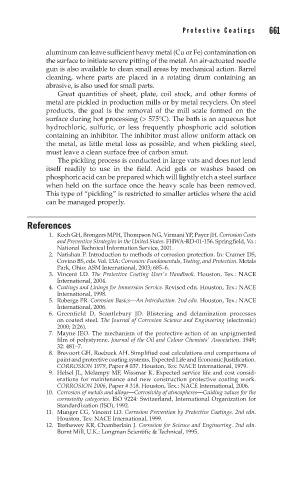Page 707 - Corrosion Engineering Principles and Practice
P. 707
660 C h a p t e r 1 4 P r o t e c t i v e C o a t i n g s 661
aluminum can leave sufficient heavy metal (Cu or Fe) contamination on
the surface to initiate severe pitting of the metal. An air-actuated needle
gun is also available to clean small areas by mechanical action. Barrel
cleaning, where parts are placed in a rotating drum containing an
abrasive, is also used for small parts.
Great quantities of sheet, plate, coil stock, and other forms of
metal are pickled in production mills or by metal recyclers. On steel
products, the goal is the removal of the mill scale formed on the
surface during hot processing (> 575°C). The bath is an aqueous hot
hydrochloric, sulfuric, or less frequently phosphoric acid solution
containing an inhibitor. The inhibitor must allow uniform attack on
the metal, as little metal loss as possible, and when pickling steel,
must leave a clean surface free of carbon smut.
The pickling process is conducted in large vats and does not lend
itself readily to use in the field. Acid gels or washes based on
phosphoric acid can be prepared which will lightly etch a steel surface
when held on the surface once the heavy scale has been removed.
This type of “pickling” is restricted to smaller articles where the acid
can be managed properly.
References
1. Koch GH, Brongers MPH, Thompson NG, Virmani YP, Payer JH. Corrosion Costs
and Preventive Strategies in the United States. FHWA-RD-01-156. Springfield, Va.:
National Technical Information Service, 2001.
2. Natishan P. Introduction to methods of corrosion protection. In: Cramer DS,
Covino BS, eds. Vol. 13A: Corrosion: Fundamentals, Testing, and Protection. Metals
Park, Ohio: ASM International, 2003; 685–6.
3. Vincent LD. The Protective Coating User's Handbook. Houston, Tex.: NACE
International, 2004.
4. Coatings and Linings for Immersion Service. Revised edn. Houston, Tex.: NACE
International, 1998.
5. Roberge PR. Corrosion Basics—An Introduction. 2nd edn. Houston, Tex.: NACE
International, 2006.
6. Greenfield D, Scantlebury JD. Blistering and delamination processes
on coated steel. The Journal of Corrosion Science and Engineering (electronic)
2000; 2(26).
7. Mayne JEO. The mechanism of the protective action of an unpigmented
film of polystyrene. Journal of the Oil and Colour Chemists' Association. 1949;
32: 481–7.
8. Brevoort GH, Roebuck AH. Simplified cost calculations and comparisons of
paint and protective coating systems, Expected Life and Economic Justification.
CORROSION 1979, Paper # 037. Houston, Tex: NACE International, 1979.
9. Helsel JL, Melampy MF, Wissmar K. Expected service life and cost consid-
erations for maintenance and new construction protective coating work.
CORROSION 2006, Paper # 318. Houston, Tex.: NACE International, 2006.
10. Corrosion of metals and alloys—Corrosivity of atmospheres—Guiding values for the
corrosivity categories. ISO 9224: Switzerland, International Organization for
Standardization (ISO), 1992.
11. Munger CG, Vincent LD. Corrosion Prevention by Protective Coatings. 2nd edn.
Houston, Tex: NACE International, 1999.
12. Trethewey KR, Chamberlain J. Corrosion for Science and Engineering. 2nd edn.
Burnt Mill, U.K.: Longman Scientific & Technical, 1995.

